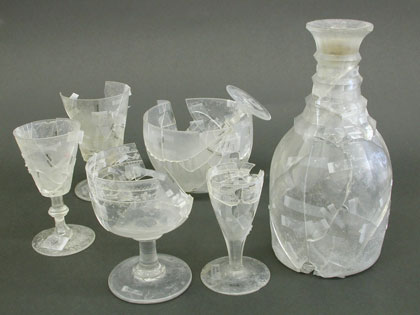Artifacts from the dining at the Château
Saint-Louis Forts and Châteaux National Historic Site
Cellars
The cellars of the Château Saint-Louis included a vegetable cellar as well as wine cellars with champagne, Saint-Macaire and Bordeaux wines, Cognac and Andaye brandy, liqueur wines from the Canaries, and port.

 Wedgwood type earthenware used at the beginning of the 19th century.
Wedgwood type earthenware used at the beginning of the 19th century. Kitchens
The kitchens were spacious and included hearths where meat roasted or cooks prepared soups in large pots hanging from the crémaillères .
A kind of warming oven made of bricks with several openings and heated by coals from the hearth served to simmer sauces. Governor Vaudreuil senior had an impressive battery of kitchen tools that included a panoply of food warmers, skillets, pots and sauce pans made of iron, brass or copper.
Beside the kitchen was a pantry for preparing confectioneries, fruits and salads; the utensils on hand bore witness to the room's separate function.
 Glass-ware
Glass-wareIn fact, all of the governor's silverware was located there, including salad bowls, mustard jars, cruet sets, food warmers, and coffee makers, not to mention part of the serving utensils with porcelain handles.
Large tables on trestles could seat dozens of guests. Interestingly, the dining room appeared only during the 18th century.
Recipes
Time to feast! Below are two period recipes tested and adapted to today's standards, which will be sure to surprise you. The first, ham on toast, taken from the Traité historique et pratique de la cuisine, published in 1758, is a canapé with which to receive guests and friends during a 5 à 7 . The second, iced cheese à la bourgeoise, is a frozen dessert from an 18th century classic of French cuisine, La Cuisinière bourgeoise, by Menon, republished on many occasions, notably by Quebec bookseller Augustin Germain in 1825.
Ham on Toast
- Slices of toasted bread
- 225 g (½ lb.) of cooked ham
- 1 ml (¼ teaspoon) nutmeg
- 15 ml (1 tablespoon) fresh chopped parsley
- 5 ml (1 teaspoon) fresh chopped chives
- 1 ml (¼ teaspoon) ground black pepper
- 1 egg
- Raisins or pine nuts
Cut the ham in pieces and place them in a food processor with the other ingredients, blending them into a smooth mixture. Spread on the toast. Garnish with raisins or pine nuts.
Iced Cheese à la Bourgeoise
- 500 ml (2 cups) 35% cream
- 250 ml (1 cup) milk
- 1 lightly beaten egg yolk
- 180 ml (¾ cup) refined sugar
- 15 to 20 ml (3 to 4 teaspoons) lemon extract or orange blossom water
- Place the cream, milk and egg yolk in a sauce pan over medium heat.
- Gradually add the sugar while beating the mixture with a wisk and bring to a boil. After 15 minutes, the cream will begin to froth; this indicates the mixture is beginning to boil. Continue beating for one minute.
- After 5 or 6 large bubbles appear, remove from heat, add the flavoring and whip slightly.
- Taste and adjust if necessary. Pour into a tin mould and freeze for four hours.
- To remove, plunge the mould into hot water for a fraction of a second; place a dish on top of the mould then turn upside down. Serve immediately.
- Date modified :